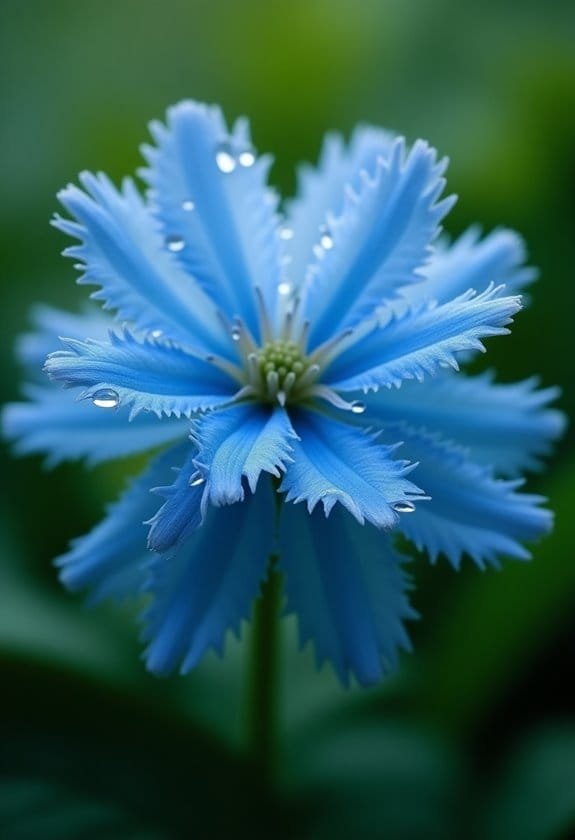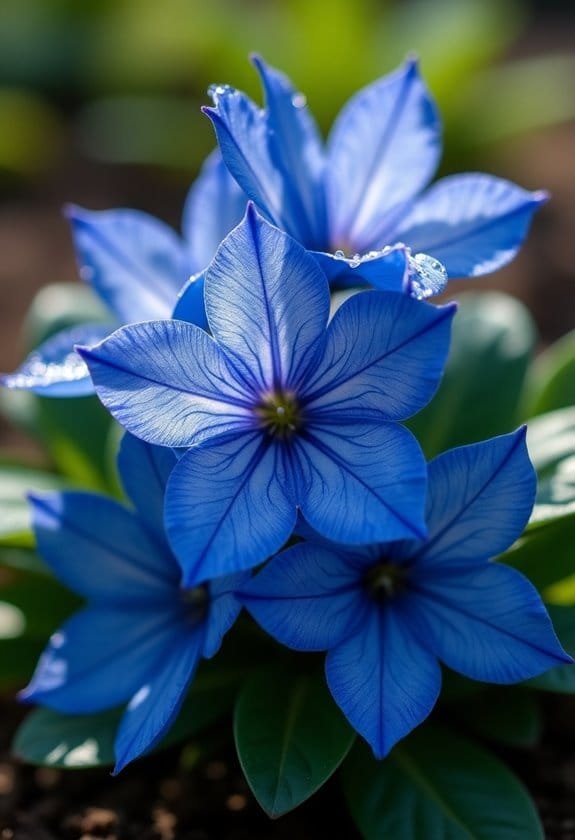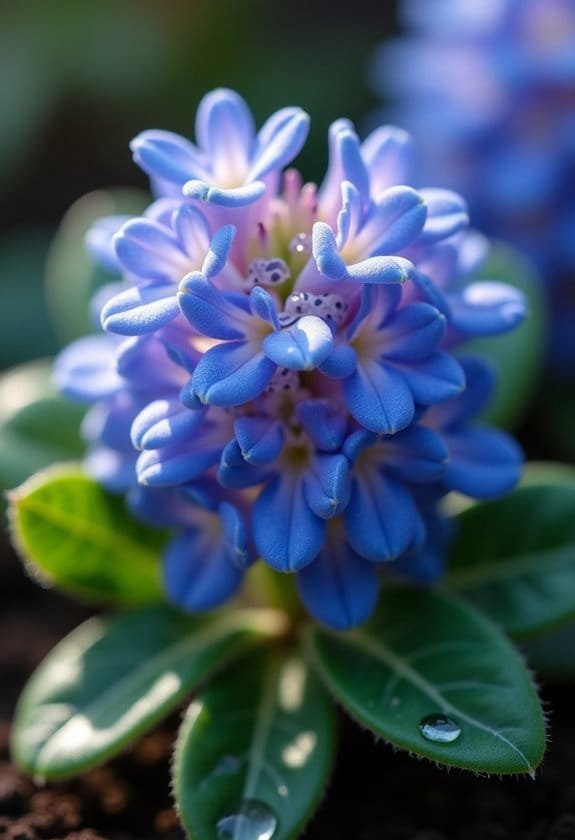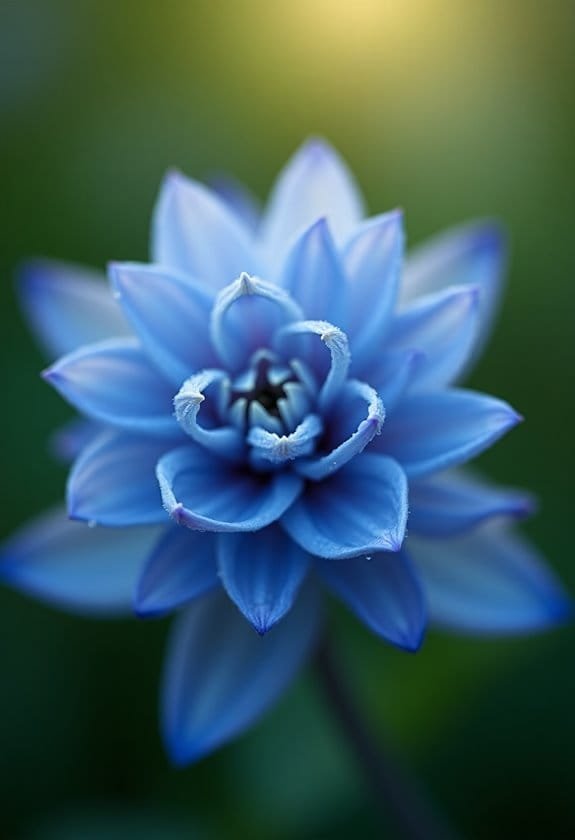Trachymene coerulea, widely recognized as the Blue Lace Flower, enchants gardeners with its striking lavender-blue blooms, a rarity in the Apiaceae family. This native of Western Australia flourishes in well-drained, organic-rich soil, requiring at least six hours of sunlight daily. The plants thrive in temperatures ranging from 65-70°F, demanding moderate moisture with weekly watering of about one inch. With its fragrant, star-shaped blossoms clustered beautifully, it attracts essential pollinators like bees and butterflies, enhancing local biodiversity. Ultimately, Trachymene coerulea serves not just as an aesthetic delight, but as a vital ecological asset, inviting further exploration of its many virtues.
Main Points
- Trachymene coerulea, or Blue Lace Flower, is known for its unique lavender-blue blooms, a rarity in the Apiaceae family.
- This plant thrives in well-drained, organic-rich soil and prefers full sun to part shade for optimal growth.
- Blooming from June to September, it produces lacey flower clusters that enhance garden aesthetics and attract beneficial pollinators.
- Minimal maintenance involves regular deadheading and monitoring for pests to prevent root rot and fungal diseases.
- Its role as a nectar source boosts local biodiversity by attracting bees and butterflies, supporting ecological health.
Introduction

The Blue Lace Flower, scientifically known as Trachymene coerulea, captivates with its enchanting lavender-blue, lacey clusters that brighten gardens.
Originating from the unique landscapes of Western Australia, this member of the Apiaceae family flourishes in ideal conditions, often characterized by well-drained, organic-rich soil and ample sunlight.
As we explore its distinct features, cultivation requirements, and blooming periods, the charm and resilience of this annual plant become evidently appealing to gardeners and botanists alike.
Common Name
Known for its delicate beauty, the Blue Lace Flower, or Trachymene coerulea, captivates garden enthusiasts with its intricate, lace-like blooms in vibrant shades of lavender-blue. This annual flower, emerging from the Apiaceae family, reflects a resemblance to its notable relative, Queen Anne's Lace, yet distinguishes itself with its unique color and form.
Blooming from June to September, and occasionally into October without frosts, the Blue Lace Flower enchants with star-shaped petals that create a mesmerizing spectacle in gardens.
Thriving in full sun to part shade, this flower flourishes best in well-drained, organic-rich soil, making it an ideal choice for cottage and cutting gardens alike. Its sweet fragrance, combined with its charming appearance, contributes to its popularity in market bouquets—capturing the hearts of florists and gardeners.
The Blue Lace Flower's ability to attract pollinators further enhances its appeal, fostering not only beauty but also essentiality in the garden ecosystem. Additionally, like the pollinator-attracting traits seen with Ajuga reptans, its vibrant blooms provide vital resources for beneficial insects.
In essence, the Blue Lace Flower stands out with its enchanting floral design and vibrant hues, making it a preferred choice for those looking to add a touch of elegance to their garden landscapes.
Scientific Name
In botanical classification, the Blue Lace Flower's scientific name, Trachymene coerulea, reflects its unique characteristics within the Apiaceae family.
This family is renowned for its aromatic plants, yet Trachymene coerulea stands out due to its striking blue blossoms, a rarity among its relatives, which mainly exhibit white or yellow flowers.
Historically, this plant was classified under the synonym Didiscus coeruleus, before being accurately reclassified to its current scientific name.
The genus name "Trachymene" derives from Greek roots meaning "rough" and "membrane," aptly describing the texture of the plant's fruit, which has a textured quality akin to lace.
The specific epithet "coerulea" translates to "blue," signifying the vivid color that makes this cut flower exceptionally engaging.
Native to Western Australia, Trachymene coerulea thrives in its natural habitat and has garnered attention from gardeners and florists alike.
Its distinct coloration and delicate appearance make it an excellent choice for ornamental uses, enhancing floral arrangements with a touch of elegance rarely found in the Apiaceae family.
This scientific characterization underscores not only its uniqueness but also the botanical intrigue surrounding this enchanting flower.
Overview
With its striking lavender-blue flowers and sweet fragrance, the Blue Lace Flower, or Trachymene coerulea, enthralls gardeners and florists alike. Originating from Western Australia, this annual plant belongs to the Apiaceae family, known for its diverse range of flowering species.
Typically reaching heights of 24 to 36 inches, it features unique flat flower heads that bloom from June to September, creating a mesmerizing display in any garden.
Thriving in full sun to part shade, the Blue Lace Flower prefers well-drained, organic-rich soils that maintain moderate moisture levels. Its delicate blooms and attractive flower clusters make it not only a visual delight but also a favorite in cutting gardens, where its long-lasting fragrance enhances arrangements beautifully.
Known colloquially as "Lacy Lavender Blue," the name reflects both the intricate flower structure and its distinctive color, which adds grace to its surroundings.
For gardeners looking to enhance their landscapes, understanding this plant's growing requirements, along with considerations like local ecological impacts, aligns with a responsible approach reflected in a detailed Privacy Policy governing plant care and preservation practices.
Key Features
The Blue Lace Flower stands out with its remarkable growth size and enchanting appearance, reaching heights of 24 to 36 inches.
From June to September, this annual delight showcases tiny lavender-blue, star-shaped flowers, creating a visual masterpiece in gardens and landscapes.
Its charming fragrance, combined with its resilience to pests, makes it a perfect candidate for enhancing borders and cutting gardens alike.
Growth Size
Blue Lace Flower, or Trachymene coerulea, typically reaches a mature height of 24 to 36 inches and spreads about 9 inches wide. This annual plant displays distinct growth characteristics that make it an intriguing addition to any garden.
The plant dimensions associated with Trachymene coerulea reflect its elegance, as it thrives in well-drained, organic-rich soil and full sun, although it can adapt to partial shade. The size variations of this flower enhance its appeal, with clusters known for their unique lace-like formations reaching diameters of around 3 inches, adding a stunning visual element at the tops of its stems.
For ideal growth, gardeners should space seeds 12 inches apart in neatly arranged rows, ensuring a planting depth of only about 1/16 inch. Such precise cultivation techniques foster healthy germination and robust development.
Furthermore, the ecological implications of its growth can't be overlooked; the Blue Lace Flower attracts various beneficial insects, enhancing garden biodiversity and promoting a balanced ecosystem.
Consequently, its growth size isn't solely a matter of aesthetics but also of environmental stewardship, inviting a spectrum of life into the garden that benefits both plants and pollinators alike.
Appearance
Showcasing its charm, Trachymene coerulea captivates with distinctive lavender-blue, star-shaped flowers that cluster into flat or rounded lacey formations at the end of its stems. Typically reaching a mature height of 24 to 36 inches, this exquisite plant possesses stems measuring 12 to 16 inches long, while its pale green leaves extend approximately 4 inches.
The striking two to three-inch diameter flower heads not only enhance its ornamental allure but also contribute sweet fragrance, making it a popular choice for floral arrangements.
The Blue Lace Flower offers subtle yet enchanting color variations that can enhance any landscape design, bringing depth and visual interest to garden spaces. Its unique structure and delightful blooms invite attention, creating a stunning showcase throughout the blooming season, particularly from June to September.
As a member of the Apiaceae family, commonly known for producing aesthetically pleasing flowers like Queen Anne's Lace, Trachymene coerulea serves both decorative and functional purposes. This native Australian species embodies an effortless blend of beauty and utility, making it a favored selection for those looking to elevate their floral displays and garden aesthetics.
Flowering Season
During the flowering season, Trachymene coerulea delights gardeners with its vibrant display from June to September, often extending into October when conditions permit. This stunning plant produces small, lavender-blue, star-shaped blooms that aggregate into a distinctive lacey structure, offering significant aesthetic benefits to any garden. Each flower releases a sweet fragrance, which not only enchants visitors but also attracts beneficial insects, thereby enhancing the ecosystem's health and productivity.
The flowering duration of the Blue Lace Flower corresponds directly with ideal conditions, which include full sun to part shade and well-drained, organic-rich soil. By practicing deadheading, gardeners can promote continuous blooming throughout the growing season, thereby extending the plant's visual appeal. This seasonal impact transforms outdoor spaces, as the delicate blooms complement other flora.
As the season progresses toward autumn, any frost-free period may allow this enchanting plant to flourish even longer, rewarding diligent caregivers. Hence, maintaining Trachymene coerulea nurtures both its beauty and ecological contributions, encouraging a cycle of growth and attraction, which consistently captivates both human and insect admirers alike. Furthermore, the ecological relationships established, such as by attracting pollinators like bees, further enhance the garden's biodiversity.
The effort invested in caring for this delightful flower is truly worthwhile.
Growing Requirements

The Blue Lace Flower flourishes under the nourishing embrace of full sun to part shade, showcasing its vibrant beauty.
It demands well-drained, organic-rich soil, where its roots can spread without drowning, ideally at temperatures between 65-70°F.
Understanding these growing requirements lays the groundwork for fostering a thriving garden that captivates the senses from June to September.
Light
For thriving blooms and robust growth, Blue Lace Flower flourishes best with a mix of full sun and part shade. This adaptable annual thrives in environments offering at least six hours of sunlight daily, which promotes ideal light exposure for the plant's health.
While it demonstrates notable shade tolerance, especially in warmer climates, it still requires direct sunlight to maintain its vibrant blooms and vigorous growth. Moderate light exposure facilitates effective growth regulation, allowing the plant to avoid the stress typically associated with excessive heat or dryness.
When growing indoors, guaranteeing consistent light during germination can considerably enhance seedling development, creating a robust foundation for future blooms.
However, in shaded areas, gardeners should endeavor to provide some direct sunlight, as this exposure is essential for cultivating strong, healthy plants that produce the desired aesthetic appeal.
Ultimately, understanding the specific light needs of Trachymene coerulea is fundamental to successful cultivation, enabling it to flourish and enchant garden enthusiasts with its delicate, lace-like flowers. Proper attention to this aspect will provide a stunning display that adds grace and elegance to any garden setting.
Soil
Ideal growth of Blue Lace Flower also hinges on the quality of the soil. This remarkable plant, known scientifically as Trachymene coerulea, flourishes in well-drained, organic-rich soil that retains moisture without becoming waterlogged. To achieve best conditions, gardeners should employ soil drainage techniques, ensuring excess water can escape and consequently prevent rot.
The flower prefers average fertility levels, making it adaptable to a variety of garden soils. When preparing the soil, it's essential to conduct soil pH testing, as a neutral pH is ideal, although the Blue Lace Flower demonstrates impressive adaptability, tolerating a range of pH levels. Incorporating organic soil amendments, such as compost, enhances nutrient availability while improving soil structure, further supporting healthy growth.
During planting, seeds should be lightly covered to promote germination in darkness, as this encourages successful sprouting.
For sustained health, regular fertilization with a complete organic fertilizer is recommended at planting and continued monthly until June. This continuous nutrient supply fosters robust development, enabling the Blue Lace Flower to dazzle in any garden landscape, embodying the beauty and intricacies of nature's designs.
Water
Ensuring proper watering is essential for the thriving growth of Blue Lace Flower (Trachymene coerulea). This plant requires approximately 1 inch of water weekly, adapting well to moderate moisture levels.
Employing effective watering techniques, such as deep watering, helps foster moisture retention in the surrounding soil, allowing roots to absorb the water they need while preventing waterlogged conditions that could damage the plant. Common Yarrow, for instance, showcases impressive drought resilience once established, further emphasizing the differences in water needs among various plant species.
The soil must be well-drained and evenly moist, as Blue Lace Flower struggles in heavy, saturated soils. During dry spells, regular watering becomes vital, particularly for seedlings and newly transplanted specimens that require additional support to establish their root systems.
It's advantageous to water in the morning, allowing any excess moisture to evaporate throughout the day, thereby reducing the risk of root rot caused by standing water. Additionally, maintaining consistent moisture levels is crucial, as seen with Common Holly(Ilex aquifolium), which reflects the importance of proper watering techniques for plant health.
Temperature
Temperature is essential for the growth of Blue Lace Flower (Trachymene coerulea), as it thrives best in moderate climates. This enchanting plant requires a favorable germination temperature of 65-70°F (19-21°C) for successful seed sprouting.
Under these ideal conditions, germination typically occurs within 20-30 days, provided the soil temperature remains consistent.
Seasonal effects considerably influence the health and productivity of the Blue Lace Flower. During summer, moderate temperatures promote robust growth, creating a harmonious environment for this delicate bloom.
However, the plant struggles in hot, dry conditions, which can stifle its development and diminish its beauty.
To maximize growth potential, gardeners should aim to sow seeds indoors 6-8 weeks before the last frost or directly outdoors once the frost has lifted.
Maintaining even soil moisture, around 1 inch per week, further enhances the plant's resilience to temperature fluctuations.
Consequently, understanding the temperature's role in nurturing Trachymene coerulea is paramount, for it dictates the plant's ability to flourish and showcase its stunning blue lace-like flowers throughout the growing season.
Such precise cultivation practices guarantee that this botanical treasure remains a delightful addition to any garden.
Pollinator Criteria
The Blue Lace Flower irresistibly draws a variety of pollinators, particularly bees and butterflies, thanks to its fragrant, nectar-rich lavender-blue blooms.
Standing at 24-36 inches tall, the plant's lacey flower clusters not only provide a striking visual appeal but also enhance accessibility for these essential insects, facilitating efficient pollination. Additionally, the Blue Lace Flower's extended flowering period supports late spring to early summer nectar availability, which is crucial for maintaining a diverse pollinator population.
This symbiotic relationship highlights the importance of planting in groups, fostering a vibrant ecosystem crucial for both the pollinators' well-being and the overall biodiversity of urban and garden landscapes. Additionally, the plant's ability to attract pollinators supports local ecosystem biodiversity, ensuring a balanced environment for various species.
Attracted Pollinators
Blue Lace Flowers attract a diverse range of pollinators, primarily due to their enchanting lavender-blue blooms and sweet scent. This plant draws bees and butterflies, which are fundamental for maintaining ecological balance. The flat, rounded lacey flower clusters provide a considerable landing surface, allowing pollinators easy accessibility to nectar.
Flower fragrances, like those emitted by the Blue Lace Flower, play an essential role in guiding pollinators, influencing their foraging patterns and behaviors.
Flowering from June to September, these blooms serve as a crucial nectar source during the peak growing season, supporting local pollinator populations. By choosing to plant Blue Lace Flowers in gardens, individuals actively promote habitat preservation. Additionally, their early-season blooming counterparts, such as the Common Cowslip(Cowslip), provide essential resources for pollinators during the spring months.
These vibrant flowers flourish in full sun and well-drained, fertile soil, conditions that enhance their attractiveness and guarantee robust blooming. Creating such pollinator-friendly environments bolsters local biodiversity, as beneficial insects find vital resources.
Enthusiastic gardeners, through thoughtful cultivation, contribute considerably to sustaining pollinator communities. The delightful appeal and ecological importance of the Blue Lace Flower make it an excellent choice for fostering healthy garden ecosystems, serving both beauty and functionality in unison.
Pollination Method
Pollination of the Blue Lace Flower relies heavily on specific characteristics of its pollinators, such as their foraging behavior and efficiency. This stunning flower, Trachymene coerulea, produces abundant nectar during its blooming period from June to September, attracting various pollinators like bees and butterflies. Their presence is crucial for effective pollination, as these organisms are drawn to the flat, lacey clusters, which offer both sustenance and a convenient resting place.
The flowers' slight fragrance further enhances their appeal, positioning them as an essential food source. When pollinators visit multiple blossoms, the likelihood of cross-pollination increases, yielding seeds with greater genetic diversity. This genetic variability is significant, as it strengthens the resilience of the species against environmental changes and diseases. The pollination benefits extend beyond mere reproduction; they contribute to overall ecosystem health.
Efficiently pollinated Blue Lace Flowers guarantee a vibrant population, which supports the local food web. Additionally, the presence of pollinators like bumblebees emphasizes the importance of maintaining diverse plant species, ensuring that essential animal partners thrive alongside floral populations. The interplay of nectar production and skilled pollinator activity underscores the intricate relationship between plants and their animal partners, showcasing nature's delicate balance and interconnectedness.
Consequently, the Blue Lace Flower thrives, perpetuating life across the landscape.
Care & Maintenance

In discussing the care and maintenance of the Blue Lace Flower, it's essential to pay attention to its planting needs and ongoing care requirements.
For ideal growth, one should confirm these plants are placed in well-drained, organic-rich soil, while also providing them with afternoon shade in warmer climates to alleviate stress.
Moreover, incorporating suitable companion plants can enhance their health and vigor, creating a thriving garden ecosystem that complements their delicate beauty.
Planting Tips
To get the most out of Trachymene coerulea, gardeners should start seeds indoors about 4-6 weeks before the last frost or directly sow them outside afterward, lightly covering them for best germination.
This delicate flower prefers well-drained soil rich in organic matter, so incorporating soil amendments such as compost can greatly enhance overall soil quality. During seed storage, maintaining a cool, dry environment is essential to guarantee germination rates remain high.
When it's time to transplant, spacing the plants 12 inches apart allows for ideal air circulation and growth. Gardeners should aim to maintain a consistent soil temperature of 70-75°F, as this temperature range fosters perfect emergence within 14-21 days. Grey Willow (Salix cinerea subsp. oleifolia) also prefers moist, nutrient-rich soils, making it a suitable companion plant for Trachymene coerulea.
Once the plants reach approximately 6 inches tall, employing effective transplanting techniques, such as pinching back the tips, encourages bushier growth and abundant flower production.
Furthermore, regular deadheading of spent flowers throughout the growing season won't only promote continuous blooming but also improve overall plant health.
For best moisture levels, moderate watering of about 1 inch per week combined with afternoon shade in hotter climates helps prevent stress, guaranteeing these enchanting blooms thrive magnificently. Additionally, planting Trachymene coerulea in a location with full sunlight will ensure they receive the necessary light for optimal growth, similar to other flowering plants like the ox-eye daisy.
Ongoing Care
Ongoing care for Blue Lace Flowers is crucial to guarantee they flourish throughout the growing season. Employing effective pruning techniques plays an important role in this process. Growers should pinch back the plants when they reach about 6 inches in height, as this encourages bushier growth and a fuller appearance.
Regular deadheading throughout the blooming season, from June to September, is critical for promoting continuous flowering.
These flowers thrive in well-drained, organic-rich soil, which necessitates careful consideration of soil amendments to optimize nutrient content. To bolster healthy growth, it's recommended to fertilize with a complete organic fertilizer at the time of planting, and then every month until June.
Seasonal adjustments, such as providing afternoon shade in hotter climates, also help mitigate stress and enhance performance.
Moderate watering, roughly once a week, maintains evenly moist soil conditions without risking waterlogging, which can be detrimental.
By diligently following these ongoing care guidelines, gardeners can enjoy the ethereal beauty of Blue Lace Flowers and witness their vibrant displays all summer long.
Fundamentally, a devoted approach to their care transforms these delicate blooms into a flourishing garden centerpiece.
Suggested Companions
Enhancing the beauty of a garden, Blue Lace Flowers pair beautifully with companions like Zinnia elegans and Daucus carota. These vibrant partners create striking color combinations, drawing attention to borders and cutting gardens alike.
When engaging in companion planting, gardeners should space these plants at least 12 inches apart to facilitate ideal growth and air circulation. To guarantee thriving plants, utilize well-drained, organic-rich soil.
Regular deadheading of Blue Lace Flowers promotes continuous blooming and minimizes competition for nutrients, thereby supporting the flourishing of companion plants. Additionally, incorporating afternoon shade during hotter months shields these delicate beauties from potential heat stress, creating an ideal environment for all plants involved.
For a cohesive garden design, group Blue Lace Flowers alongside hardy annuals that flourish in similar conditions, particularly full sun to part shade, requiring moderate watering.
Such thoughtful combinations not only elevate visual appeal but also enhance overall plant health, fostering a harmonious ecosystem within the garden. By carefully selecting companions and implementing strategic planting techniques, gardeners can achieve an enchanting landscape that showcases both individual plant beauty and the collective splendor of their floral companions.
Common Issues
Despite its general resistance to major pests and diseases, the Blue Lace Flower can still encounter some common challenges.
Overwatering poses a significant threat, as it can lead to root rot, while insufficient deadheading diminishes blooming potential and overall vigor.
Observing these factors helps gardeners proactively address issues, ensuring their trachymene coerulea thrives throughout the season.
Pests/Diseases
Maintaining Blue Lace Flowers (Trachymene coerulea) is generally straightforward, as these plants exhibit minimal pest and disease issues. However, gardeners should remain vigilant, as occasional pests like aphids may emerge, though they typically pose little threat due to the plant's inherent hardiness.
Implementing effective pest management strategies, such as regular monitoring, can noticeably reduce the likelihood of infestations from spider mites and whiteflies.
Fungal diseases can arise, particularly in conditions where plants are overwatered or situated in poorly drained soils. Therefore, it's essential to adopt disease prevention techniques that emphasize proper watering practices and guarantee well-drained conditions.
Gardeners should educate themselves on the signs of distress—such as wilting or discoloration—confirming they can address potential issues before they escalate.
When problems do arise, exploring organic treatment options can be beneficial; methods like neem oil or insecticidal soaps offer eco-friendly solutions to combat pests without harming the environment.
Solutions
When gardeners encounter common issues with Blue Lace Flowers (Trachymene coerulea), effective solutions often stem from understanding the plant's needs. To thrive, these flowers require well-drained, organic-rich soil; heavy, compacted soils can impede their health considerably.
Implementing soil amendments, such as compost, enhances drainage and enriches nutrients, supporting robust growth.
Gardeners can also enhance plant vigor by employing specific planting techniques. Spacing the plants at least 12 inches apart fosters adequate air circulation, minimizing the risk of fungal diseases that often plague crowded gardens.
Pinching off stem tips when they reach approximately 6 inches encourages bushier growth, reducing leggy appearances and making plants more visually appealing.
Furthermore, ensuring that Blue Lace Flowers receive full sun to partial shade is essential for ideal flowering, as inadequate light leads to stunted growth and fewer blooms.
Regular deadheading of spent flowers from June to September extends the blooming period, allowing gardeners to enjoy vibrant displays well into October, barring frost.
Summary

The Blue Lace Flower, known scientifically as Trachymene coerulea, captivates garden enthusiasts with its striking lavender-blue, star-shaped blooms that flourish from June to September.
This annual plant, reaching heights of 24-36 inches, thrives best in well-drained, organic-rich soils and prefers full sun to part shade, making it a versatile choice for landscape design.
With its delightful fragrance, the Blue Lace Flower serves not only as an aesthetic delight but also plays a crucial role in cultural significance, often featured in bouquets for its beauty and sweet aroma.
Propagation techniques for this plant include starting seeds indoors before the last frost or directly seeding outdoors, ensuring vibrant blooms during the growing season.
The recommended spacing of 12 inches between plants allows for peak growth, creating a lush garden display.
Furthermore, the Blue Lace Flower attracts beneficial insects, contributing positively to garden biodiversity and ecosystem health. Notably, its bloom pattern, similar to pollinator-attracting flowers, enhances its effectiveness in supporting pollinators in the garden.


